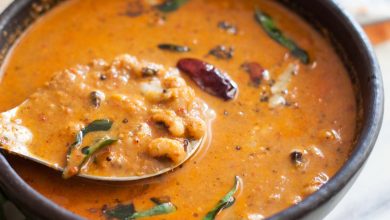Kerala Style Appam Recipe – Fermented Rice Pancakes with Coconut
Kerala Style Appam, also known as fermented rice pancakes, are a traditional dish from the coastal state of Kerala in India. These soft and airy pancakes are made from a batter of fermented rice, cooked rice, and freshly grated coconut, resulting in a rich and flavorful delight. The beauty of Appam lies in its texture – thick and fluffy in the center with thin, crispy edges, making it perfect to pair with dishes like Kadala Curry (black chickpea curry) or Kerala Style Vegetable Stew.
Ingredients
| Ingredient | Quantity |
|---|---|
| Rice (raw) | 2 cups |
| Cooked rice | 1 cup |
| Fresh coconut (freshly grated) | 1 cup |
| Active dry yeast | 1 teaspoon + 1/2 cup lukewarm water |
| Sugar | 2 tablespoons |
| Salt | To taste |
Preparation Time: 3 hours 20 minutes
Cook Time: 30 minutes
Total Time: 3 hours 50 minutes
Servings: 4
Cuisine: Kerala
Course: Main Course
Diet: Vegetarian
Instructions
Step 1: Soaking the Rice
To begin the Kerala Style Appam, soak the raw rice in water for about 3 to 4 hours. This will soften the rice and make it easier to grind into a smooth batter.
Step 2: Activating the Yeast
While the rice is soaking, take a small bowl and mix the sugar, salt, and active dry yeast with 1/2 cup of lukewarm water. Stir well and allow the mixture to sit for 5 minutes to activate the yeast. If you’re using instant dry yeast, you can skip the proofing step and add it directly to the batter later.
Step 3: Grinding the Rice and Coconut
After soaking, drain the rice. Combine the soaked rice, cooked rice, and freshly grated coconut in a blender or food processor. Add a little water as needed, and blend the mixture into a smooth and thick batter. The consistency should be slightly thicker than pancake batter.
Step 4: Mixing the Yeast
Once the rice and coconut mixture is smooth, pour the activated yeast mixture into the batter and mix well to incorporate it evenly. Stir thoroughly so the yeast is evenly distributed in the batter.
Step 5: Fermenting the Batter
Transfer the batter into a large bowl, cover it with a cloth, and set it aside in a warm place for fermentation. Allow the batter to ferment for 5 to 6 hours or, for best results, let it sit overnight. The batter should rise and develop a slight sour aroma due to the fermentation process.
Step 6: Adjusting the Consistency
Once the batter has fermented, check its consistency. It should be thick but pourable. If it’s too thick, gradually add water to achieve a consistency that is easy to pour and spread in the pan. If the batter is too watery, the Appams won’t turn out soft, and they won’t spread properly when cooked.
Step 7: Cooking the Appams
Next, heat an Appam pan (also called an Appachetty) or a non-stick frying pan over medium-high heat. Once it’s hot, pour a ladle of the batter into the center of the pan.
Step 8: Spreading the Batter
Swirl the pan gently in a circular motion, allowing the batter to spread evenly. The batter should be thick in the center, creating a raised dome, and thin at the edges, which will become crispy as they cook.
Step 9: Steaming and Crisping
Cover the pan with a lid and cook the Appam for 2 minutes or until the sides are golden brown and crispy. The center should remain soft and steamed. The key is to allow the Appam to cook through while keeping the delicate texture intact.
Step 10: Serving
Carefully remove the Appam from the pan and serve it immediately with Kadala Curry (Kerala-style black chickpea curry) or a comforting bowl of Kerala Style Vegetable Stew. You can also enjoy it with coconut milk or sweetened coconut cream for a traditional experience.
Tips for Perfect Appams
- Fermentation: The batter’s fermentation is essential for achieving the signature tangy flavor and light texture of Appam. Make sure to give it ample time to ferment, ideally overnight.
- Consistency: Adjusting the batter’s consistency is crucial. If it’s too runny, the Appams will not form properly. If it’s too thick, they will not spread well on the pan.
- Pan Temperature: Make sure the pan is well-heated but not too hot, as this can cause the Appams to burn. Medium-high heat works best for cooking them evenly.
Nutritional Information (per serving)
| Nutrient | Amount per serving |
|---|---|
| Calories | ~210 kcal |
| Carbohydrates | ~40g |
| Protein | ~4g |
| Fat | ~4g |
| Fiber | ~2g |
| Sodium | ~100mg |
(Note: Nutritional values are estimates and may vary based on the specific ingredients used.)
Conclusion
Kerala Style Appam is a beloved dish that brings the rich culinary traditions of Kerala to your table. Its soft, spongy center and crispy edges make it a versatile accompaniment to a variety of curries, especially the traditional Kadala Curry or Kerala Vegetable Stew. With just a few ingredients and some patience, you can create this delicious, gluten-free treat that will transport you to the tropical flavors of southern India. Enjoy it for breakfast, lunch, or dinner, and savor the comforting flavors of Kerala in every bite!



